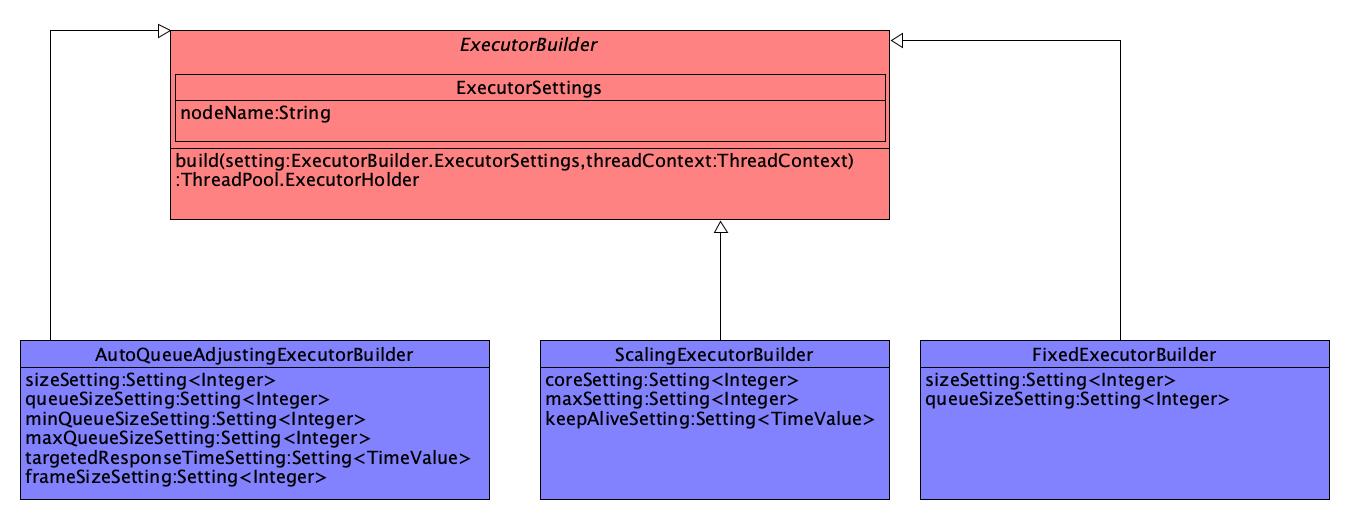(1). 概述
这一节主要剖析:ES的线程池.
(2). 查看Scheduler的实现

(3). 查看ExecutorBuilder类关系图
ExecutorBuilder是构建线程池的策略,不同的策略,构建出不同的线程池.
AutoQueueAdjustingExecutorBuilder : 带有队列功能的线程池.
ScalingExecutorBuilder : 具有弹性伸缩的线程池.
FixedExecutorBuilder : 固定大小的线程池.

(4). 查看Scheduler的接口行为
public interface Scheduler {
// TODO ... ...
// ****************************************************************************
// 定时调度,留给实现类去做实现
// ****************************************************************************
ScheduledCancellable schedule(Runnable command, TimeValue delay, String executor);
default Cancellable scheduleWithFixedDelay(
Runnable command,
TimeValue interval,
String executor) {
return new ReschedulingRunnable(
command, interval, executor, this, (e) -> {}, (e) -> {}
);
}// end scheduleWithFixedDelay
interface Cancellable {
boolean cancel();
boolean isCancelled();
} // end Cancellable
interface ScheduledCancellable extends Delayed, Cancellable {}
// TODO ... ...
}
(5). ThreadPool
public ThreadPool(final Settings settings, final ExecutorBuilder<?>... customBuilders) {
assert Node.NODE_NAME_SETTING.exists(settings);
final Map<String, ExecutorBuilder> builders = new HashMap<>();
// 根据CPU的数量来获取的
// 4
final int availableProcessors = EsExecutors.numberOfProcessors(settings);
// 2
final int halfProcMaxAt5 = halfNumberOfProcessorsMaxFive(availableProcessors);
// 2
final int halfProcMaxAt10 = halfNumberOfProcessorsMaxTen(availableProcessors);
// 128
final int genericThreadPoolMax = boundedBy(4 * availableProcessors, 128, 512);
// 构建线程池的数量和名称.
builders.put(Names.GENERIC, new ScalingExecutorBuilder(Names.GENERIC, 4, genericThreadPoolMax, TimeValue.timeValueSeconds(30)));
builders.put(Names.WRITE, new FixedExecutorBuilder(settings, Names.WRITE, availableProcessors, 200));
builders.put(Names.GET, new FixedExecutorBuilder(settings, Names.GET, availableProcessors, 1000));
builders.put(Names.ANALYZE, new FixedExecutorBuilder(settings, Names.ANALYZE, 1, 16));
builders.put(Names.SEARCH, new AutoQueueAdjustingExecutorBuilder(settings,
Names.SEARCH, searchThreadPoolSize(availableProcessors), 1000, 1000, 1000, 2000));
builders.put(Names.SEARCH_THROTTLED, new AutoQueueAdjustingExecutorBuilder(settings,
Names.SEARCH_THROTTLED, 1, 100, 100, 100, 200));
builders.put(Names.MANAGEMENT, new ScalingExecutorBuilder(Names.MANAGEMENT, 1, 5, TimeValue.timeValueMinutes(5)));
// no queue as this means clients will need to handle rejections on listener queue even if the operation succeeded
// the assumption here is that the listeners should be very lightweight on the listeners side
builders.put(Names.LISTENER, new FixedExecutorBuilder(settings, Names.LISTENER, halfProcMaxAt10, -1));
builders.put(Names.FLUSH, new ScalingExecutorBuilder(Names.FLUSH, 1, halfProcMaxAt5, TimeValue.timeValueMinutes(5)));
builders.put(Names.REFRESH, new ScalingExecutorBuilder(Names.REFRESH, 1, halfProcMaxAt10, TimeValue.timeValueMinutes(5)));
builders.put(Names.WARMER, new ScalingExecutorBuilder(Names.WARMER, 1, halfProcMaxAt5, TimeValue.timeValueMinutes(5)));
builders.put(Names.SNAPSHOT, new ScalingExecutorBuilder(Names.SNAPSHOT, 1, halfProcMaxAt5, TimeValue.timeValueMinutes(5)));
builders.put(Names.FETCH_SHARD_STARTED,
new ScalingExecutorBuilder(Names.FETCH_SHARD_STARTED, 1, 2 * availableProcessors, TimeValue.timeValueMinutes(5)));
builders.put(Names.FORCE_MERGE, new FixedExecutorBuilder(settings, Names.FORCE_MERGE, 1, -1));
builders.put(Names.FETCH_SHARD_STORE,
new ScalingExecutorBuilder(Names.FETCH_SHARD_STORE, 1, 2 * availableProcessors, TimeValue.timeValueMinutes(5)));
// 添加自定义的线程池信息
for (final ExecutorBuilder<?> builder : customBuilders) {
if (builders.containsKey(builder.name())) {
throw new IllegalArgumentException("builder with name [" + builder.name() + "] already exists");
}
builders.put(builder.name(), builder);
}
// 不可变Map
// builders.length = 22
this.builders = Collections.unmodifiableMap(builders);
// 创建线程上下文,包裹着配置文件
threadContext = new ThreadContext(settings);
// ******************************************************************
// 前面创建了很多的线程池的配置信息(最小核心数,最大核心数,队列数...)
// 这一步:
// 1. 会根据上面的:ExecutorBuilder对象,创建出对应的:ExecutorService
// 2. 创建出ExecutorHolder,包裹着:上一步的实例:ExecutorService
// 3. 注意:ExecutorService(线程池可还没有启动)
// ******************************************************************
final Map<String, ExecutorHolder> executors = new HashMap<>();
// 遍历所有的:ExecutorBuilder
for (final Map.Entry<String, ExecutorBuilder> entry : builders.entrySet()) {
// 获得配置项(最小核心数,最大核心数,队列数...)
final ExecutorBuilder.ExecutorSettings executorSettings =
entry.getValue().getSettings(settings);
// *********************************************************
// 在这里,我以:ScalingExecutorBuilder为例
// ScalingExecutorBuilder.build
// *********************************************************
// 调用:build构建:ExecutorHolder,这个类,内部实际是Holder住:ExecutorService(JDK线程池)
final ExecutorHolder executorHolder =
entry.getValue().build(executorSettings, threadContext);
if (executors.containsKey(executorHolder.info.getName())) {
throw new IllegalStateException("duplicate executors with name [" + executorHolder.info.getName() + "] registered");
}
logger.debug("created thread pool: {}", entry.getValue().formatInfo(executorHolder.info));
executors.put(entry.getKey(), executorHolder);
}
// 针对:same独特处理
executors.put(Names.SAME, new ExecutorHolder(DIRECT_EXECUTOR, new Info(Names.SAME, ThreadPoolType.DIRECT)));
// executors.size = 23
// ThreadPool持有这个:executors
this.executors = unmodifiableMap(executors);
// 过滤出名称不是:same的Info信息
// infos.size = 22
final List<Info> infos =
executors
.values()
.stream()
.filter(holder -> holder.info.getName().equals("same") == false)
.map(holder -> holder.info)
.collect(Collectors.toList());
// ThreadPoolInfo包裹所有的:infos
this.threadPoolInfo = new ThreadPoolInfo(infos);
// *************************************************************
// 8. 初始化定时调度(Scheduler.initScheduler)
// *************************************************************
this.scheduler = Scheduler.initScheduler(settings);
// 创建:cached线程.
TimeValue estimatedTimeInterval = ESTIMATED_TIME_INTERVAL_SETTING.get(settings);
this.cachedTimeThread = new CachedTimeThread(EsExecutors.threadName(settings, "[timer]"), estimatedTimeInterval.millis());
this.cachedTimeThread.start();
} // end ThreadPool
// 根据name获得相应的:ExecutorService
public ExecutorService executor(String name) {
final ExecutorHolder holder = executors.get(name);
if (holder == null) {
throw new IllegalArgumentException("no executor service found for [" + name + "]");
}
return holder.executor();
}// end executor
// 调度
public ScheduledCancellable schedule(Runnable command, TimeValue delay, String executor) {
// 如果executor不是:same
if (!Names.SAME.equals(executor)) {
// 典型组合模式.
// 通过:ThreadedRunnable包裹着:Runnable和Executor
command = new ThreadedRunnable(command, executor(executor));
}
// scheduler.schedule(...)方法会返回:ScheduledFuture
// ScheduledCancellableAdapter包裹着:ScheduledFuture,可实现取消功能.
return new ScheduledCancellableAdapter(scheduler.schedule(command, delay.millis(), TimeUnit.MILLISECONDS));
}// end schedule
(6). ScalingExecutorBuilder.build
ScalingExecutorBuilder是可弹性伸缩的线程池配置.
ThreadPool.ExecutorHolder build(
// 创建线程池需要的配置项
final ScalingExecutorSettings settings,
// ThreadContext持有着的是配置文件(Settings).
final ThreadContext threadContext) {
// 存活时间
TimeValue keepAlive = settings.keepAlive;
// 核心线程数
int core = settings.core;
// 最大线程数
int max = settings.max;
// 构建:ThreadPool.Info,线程池的基本信息.
final ThreadPool.Info info = new ThreadPool.Info(
name(),
ThreadPool.ThreadPoolType.SCALING,
core,
max,
keepAlive,
null
);// end ThreadPool.Info
// 创建线程工厂,后台线程工厂.
final ThreadFactory threadFactory = EsExecutors.daemonThreadFactory(
EsExecutors.threadName(settings.nodeName, name())
);
// **********************************************
// 7. 调用:EsExecutors对象去创建线程池
// **********************************************
final ExecutorService executor =
EsExecutors.newScaling(
settings.nodeName + "/" + name(),
core,
max,
keepAlive.millis(),
TimeUnit.MILLISECONDS,
threadFactory,
threadContext);
// 创建: ThreadPool.ExecutorHolder包裹着: ExecutorService 和 ThreadPool.Info
return new ThreadPool.ExecutorHolder(executor, info);
} // end build
(7). EsExecutors.newScaling
public class EsExecutors {
// 创建弹性线程池
public static EsThreadPoolExecutor newScaling(String name, int min, int max, long keepAliveTime, TimeUnit unit,
ThreadFactory threadFactory, ThreadContext contextHolder) {
// 创建弹性队列.
ExecutorScalingQueue<Runnable> queue = new ExecutorScalingQueue<>();
EsThreadPoolExecutor executor =
// ForceQueuePolicy 为拒绝策略.
new EsThreadPoolExecutor(name, min, max, keepAliveTime, unit, queue, threadFactory, new ForceQueuePolicy(), contextHolder);
queue.executor = executor;
return executor;
}// end newScaling
}
(8). Scheduler.initScheduler
static ScheduledThreadPoolExecutor initScheduler(Settings settings) {
// 创建定时任务执行器
final ScheduledThreadPoolExecutor scheduler =
new SafeScheduledThreadPoolExecutor(1,
EsExecutors.daemonThreadFactory(settings, "scheduler",
new EsAbortPolicy());
scheduler.setExecuteExistingDelayedTasksAfterShutdownPolicy(false);
scheduler.setContinueExistingPeriodicTasksAfterShutdownPolicy(false);
scheduler.setRemoveOnCancelPolicy(true);
return scheduler;
} // end initScheduler
class SafeScheduledThreadPoolExecutor extends ScheduledThreadPoolExecutor {
public SafeScheduledThreadPoolExecutor(
int corePoolSize,
ThreadFactory threadFactory,
RejectedExecutionHandler handler) {
super(corePoolSize, threadFactory, handler);
}
}
(9). 总结
- 为不同的名称:ThreadPool.Names,创建相应的线程池参数(ExecutorBuilder).临时存储在Map里.
- 遍历第一步的Map,调用:ExecutorBuilder.build方法创建:ExecutorHolder(ExecutorService).key=ThreadPool.Names,value=ExecutorHolder.
- 初始化ES定义的:Scheduler.initScheduler(xxx).
- Scheduler.schedule()相当于是代理所有的:ExecutorService去执行任务.
